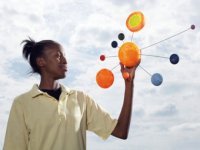Providing STEM Role Models
Science role models were key to my journey. A pinnacle moment was when I watched a show on PBS called 3-2-1 Contact, which featured a segment with a teenaged black girl solving problems. When I saw her doing science, I was irrevocably hooked.
The Robin Hood of Science
Using my own experience as a reference, I was convinced that science role models would be helpful to other children. So at Yale, I created a science program for kids called Science Saturdays. For all the Saturdays in April and October, we would have a science show based on the 3D’s: donuts, demonstrations and dynamic talks. This science lecture show featured scientists that had the ability to convey science in an understandable way. This venue gave kids and adults the opportunity to interact with a scientist and ask any question they wanted. And the scientists got to feel like rock stars. It was a science love fest. Science Saturdays was a unique space, and I felt lucky to steward it for nearly a decade.
In many ways, I was the Robin Hood of science. The cost of admission was free, and no registration was required. I felt like a friend who, after getting into an exclusive nightclub, then opens the back door to let other friends in. My gift to New Haven kids was to pry open a door to science, using donuts to entice them.
Everyone Wins When Science is Fun
Everyone who attended Science Saturdays won. Undergrads staffed the demonstration table, and they got to show off their maturing science knowledge by teaching younger kids. Families won at Science Saturdays because moms and dads got to connect with their children in new ways. It was not uncommon to see a row in the audience with a family that contained several generations from grandparents to grandkids. The science presenters won because they got a fully engaged audience ripe with questions and came away feeling like celebrities. But most of all, the kids won. They got science served just the way they needed it in a space where it was OK to ask questions and learn.
I saw many things that made my heart happy. I saw little girls blossom in this environment. One Saturday, a timid little girl came and asked if she could demonstrate her science project at the demo table. In her hand was a plastic soda bottle covered with duct tape and some indescribable liquid inside. I had no idea what this was, but she needed room to set up. She got it. I cleared space for her at the demo table. Towering over her were undergraduates, but she got right in there and showed her demo to all who wanted to hear about it (and some that didn't). She gained a confidence I had not seen in her before -- and it was wonderful to see. Science can do that for a child.
Build Fun Science Programs and They Will Come
If science is taught in an engaging way, children will come. After a lecture was over, a mother shared with me a story about her kids. The week before had been their first Science Saturdays. So getting them up was the usual drudgery. They got to Science Saturdays a bit late due to lots of shoe dragging. However, when they sat down (with donuts in hand), they stayed in their seats for an hour listening intently to the presenter, and even wanted to shake the scientist's hand afterward.
A week had passed, and it was time to get ready for Science Saturdays again. The mother prepared for the shoe dragging that happened a week before. To her surprise, the kids were washed, dressed, had eaten cereal (but not too much, because there would be donuts) and were ready to go.
Something had body-snatched these kids. They were transformed in a matter of days. Fun science can do that.
Science Saves
There was another case when I got a letter in the mail from a Science Saturdays attendee. I recall that day was a hard day. Putting the event together felt like an act of Congress. Even though it had been around for years, it always took some doing to get it organized. I was feeling that burden heavily on that particular day.
Credit: ShutterstockI opened up the letter. It was from a young man who wanted to let me know that he hadn't known what he wanted to do in his life. He was in high school but ready to drop out. He came to a Science Saturdays lecture that discussed "How to Make an Organ from a Petri Dish," given by the highly engaging Dr. Erin Lavik, who is an approachable biomedical engineering genius. The young man wrote that he was blown away by the talk, decided to register at the local community college and was now taking biomedical engineering classes. He was writing to thank me for putting together this program, and to let me know that if I ever wondered whether I was having an impact, I should have no doubt. Science Saturdays saved him.
Science taught well can inspire, can make the timid confident, and can change lives. Fun science is a right, and these stories show the power of how it can transform. This is why we have to take science back and teach it to our children in ways that make their imaginations soar. By showing people another way to engage with science, as simple as a lecture program may be, it can sometimes make all the difference. I know for certain that science can do this. I have witnessed this beautiful thing.
